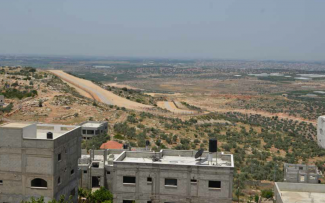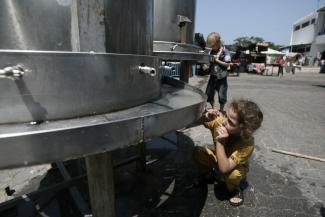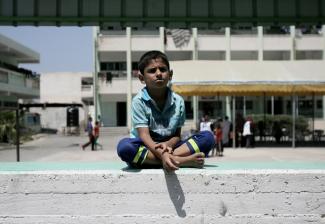The rerouting of the Barrier in Jayyus (population 2,894) in Qalqiliya governorate was completed on 7 September. Jayyus has 13,000 dunums of land and more than 50 per cent of the population depend totally on agriculture for their livelihoods. Around 2,400 dunums of land and two artesian wells (one unused) have been returned to the ‘Palestinian’ side of the Barrier. This land can now be accessed by farmers without permits for the first time since 2003. According to the Village Council, the rerouting resulted in the uprooting of approximately 75 fruit trees and 350 olive trees, the majority of which have been replanted.
The Monthly Humanitarian Bulletin | September 2014
In this document
The extensive Israeli aerial bombardment, naval shelling and artillery fire during the last round of hostilities had devastating results on public infrastructure, including water and sanitation. The Coastal Municipalities Water Utility (CMWU), which is the main provider of water and sanitation services, estimates that between 70 and 80 per cent of the network is now functional following emergency repairs carried out during and since the ceasefire. The remaining 20-30 per cent of the network that remains inoperable is concentrated in the worst-hit areas, primarily within the three-kilometre-wide buffer zone declared by Israel during the hostilities.
Since mid-September, UNRWA, UNDP and the Ministry of Public Works and Housing (MoPWH) in Gaza have been conducting assessments of homes affected by the hostilities to assess the level of damage and identify shelter needs. Although these assessments are ongoing, they reveal an unprecedented number of damaged and destroyed housing units. Current estimates indicate that 29 per cent of Gaza’s total housing stock has been affected, which is more than double the initial estimate.
Given the scale of the emerging crisis triggered by the July-August hostilities, it was critical to ensure that much needed resources would be on the ground as fast as possible. To ensure this, in addition to the regular funding to humanitarian agencies and the special funding obtained via the Gaza Crisis Appeal, the Humanitarian Country Team (HCT) mobilised over US$16 million from two pooled funds: the CERF, which is managed by a secretariat in New York on behalf of the Emergency Response Coordinator, and the ERF, which is managed in-country by the Humanitarian Coordinator with the support of OCHA and a technical review board of humanitarian partners and an advisory board of donors.
Over the course of hostilities, significant numbers of unexploded aircraft bombs, tank shells and other ammunition, from both Israeli forces and Palestinian armed groups, have been reported in civilian areas across the Gaza Strip. While the exact level of Explosive Remnants of War (ERW) contamination is unknown, based on the scope of damage to buildings and a minimum failure rate of 10 per cent, the UN Mine Action Service (UNMAS) estimated that a minimum of 7,000 explosive items remain to be secured or destroyed.
The Palestinian Ministry of Agriculture (MoA) announced that 3 October is the official start of the olive harvest season. The annual olive harvest is a key economic, social and cultural event for Palestinians. Approximately half of the agricultural land in the oPt is planted with eight million olive trees, the majority (94 per cent) of them in the West Bank. The olive oil industry makes up 25 per cent of the agricultural income of the oPt and estimates suggest that about 100,000 families depend to some extent on the annual olive harvest for their livelihoods.
Gaza’s agricultural sector sustained over US$500 million in damage during the recent conflict: around twice the total under Operation Cast Lead according to the Palestinian Ministry of Agriculture. This is Gaza’s third such conflict in six years and by far the most destructive for its already beleaguered agricultural sector. Around 24,000 families of farmers, herders and fishermen suffered debilitating losses. Without urgent support, livelihoods will further erode as more animals die, fields lie barren and fishermen lack the means to pursue their livelihoods.
Further settlement activity took place in East Jerusalem during this month. In recent years, settler organizations have targeted land and property in the midst of densely populated Palestinian residential areas in East Jerusalem, in the so-called ‘Holy Basin’ area in and around the Old City. An estimated 2,000 settlers reside in this area in houses which have been expropriated by means of the Absentee Property Law; on the basis of alleged former Jewish ownership; in buildings purchased from Palestinian owners; and in residences custom-built and financed by settler organizations.

















